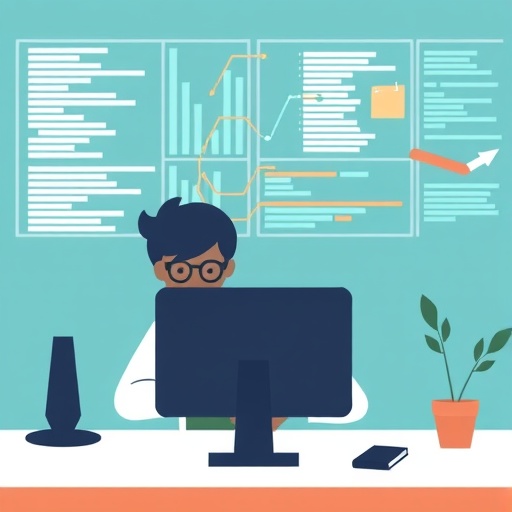In an era defined by rapid technological advancement, the ability to understand and write computer code has become an invaluable skill, reshaping the landscapes of education, employment, and innovation. But beyond the practical implications, what happens inside the human brain when we learn programming? Recent research by scientists at Johns Hopkins University sheds light on this question by exploring how our brains adapt when we acquire the ability to program in Python, one of the world’s most popular programming languages.
The study, published in JNeurosci, investigated the neural mechanisms underlying the acquisition of programming skills. The researchers focused on the idea that learning programming may not require developing entirely new brain functions. Instead, it could involve the repurposing of preexisting brain networks that originally evolved to support other cognitive activities. This hypothesis is grounded in prior work on cultural skills such as reading and mathematics, where it has been demonstrated that the brain often reallocates existing networks to manage these relatively recent technological competencies.
In their experiment, Liu and Bedny recruited participants with no prior programming experience and scanned their brain activity using functional magnetic resonance imaging (fMRI) before and after they learned Python. Intriguingly, even before formal training, when participants read descriptions of programming algorithms written in English, the brain regions most strongly activated were not the traditional language processing areas. Instead, the left frontoparietal network, associated with logical reasoning and problem-solving, exhibited significant activity. This suggests that understanding the abstract logic behind algorithms engages cognitive systems tuned for reasoning rather than linguistic processing.
This finding challenges conventional assumptions. One might expect the language centers of the brain to be engaged when reading algorithm explanations, which were presented in plain English. However, the dominance of the logical reasoning network underscores how programming concepts may tap into more fundamental cognitive capacities related to systematic thinking and problem structuring. The ability of the brain to allocate such specialized but preexisting neural resources underscores the flexibility and adaptability of human cognition.
After the participants underwent training and learned to write Python code proficiently, the fMRI scans revealed that the same frontoparietal network was further engaged, this time in response to actual code rather than descriptive text. This neural recycling indicates that learning to program involves the brain repurposing these reasoning areas to process symbolic and syntactic structures unique to programming languages. The reactivation and potential strengthening of these logical algorithm codes signify a neural adaptation that underpins programming skill acquisition.
These insights contribute to a broader understanding of how cultural and technological learning co-opts brain circuitry originally designed for evolutionary older functions. Programming, much like reading or numerical cognition, appears not to require novel brain areas but rather the functional reassignment of existing ones. This concept of neural reuse highlights the remarkable plasticity of the human brain and suggests that educational approaches might be tailored to leverage these cognitive pathways for more effective instruction in programming and other STEM fields.
The research team is particularly interested in exploring the implications of these findings for individual differences in learning programming. Specifically, they aim to determine whether a person’s aptitude in logical reasoning tasks can predict their success in mastering programming languages. If a strong correlation exists, it could revolutionize programming education by allowing personalized learning strategies that cater to cognitive strengths or weaknesses.
Moreover, understanding the brain networks involved in programming opens avenues for developing neurocognitive interventions aimed at enhancing programming skills through targeted cognitive training. This could have significant applications in education technology, helping learners overcome difficulties and achieve more rapid proficiency.
While the current study focuses on Python as a programming language due to its widespread adoption and relative accessibility, future research may investigate whether different languages, especially those with varying levels of abstraction or syntax complexity, engage neural networks differently. Such work could elucidate whether the brain’s approach to learning programming is generally uniform or language-specific, aiding curriculum designers in selecting optimal languages for novices.
Beyond the immediate educational implications, these findings invite reflection on how evolving technologies continue to shape human cognition. As programming becomes increasingly integrated into diverse fields—including biology, finance, and the arts—the ways in which brains adapt to these interdisciplinary demands may illuminate the future trajectory of cognitive evolution.
The study was supported by the U.S. National Science Foundation and represents a significant advance in cognitive neuroscience. By revealing how logical reasoning networks are “recycled” during the learning of programming, the work contributes not only to educational neuroscience but also to a broader understanding of how cultural inventions reshape the brain’s functional architecture.
In sum, the Johns Hopkins research unravels a key aspect of the cognitive neuroscience of programming: the brain’s remarkable ability to adapt preexisting logical reasoning circuits to acquire and process programming languages. This discovery enriches our comprehension of brain plasticity and offers promising directions for optimizing the teaching and learning of essential digital skills in the modern world.
Subject of Research: People
Article Title: Learning to Program “Recycles” Preexisting Frontoparietal Population Codes of Logical Algorithms
News Publication Date: 27-Oct-2025
Web References: http://dx.doi.org/10.1523/JNEUROSCI.0314-25.2025
Keywords: Computer programming, Programming languages, Learning, Learning processes, Algorithms




